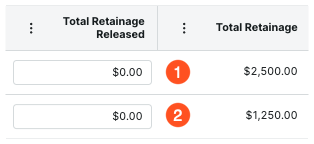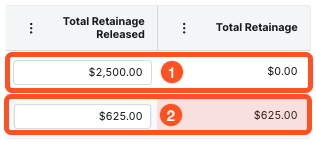Create a Subcontractor Invoice for Release of Retainage in the Invoicing Tool
Objective
To create a subcontractor invoice for the release of retainage as a final payment.
Background
In Procore, the term Retainage refers to the practice of withholding of a portion of a contract amount until the work is deemed satisfactorily complete. The withheld amount is specified in an agreement between the contracting party (the party paying for the work) and a contracted party (the person or company performing the work). A common practice is to withhold 5-10% of a contract's total value until a milestone is reached. Then, the withheld amount can be released as a progress payment. When work is substantially complete, the withheld amount can be released.
Things to Consider
Prerequisites
Steps
- Navigate to the project's Commitment tool.
- Go to Commitment for the invoice you want to distribute.
- Click the Invoicing tab.
- Choose from these options in the Subcontractor tab:
- To modify an existing invoice, locate the 'Draft' invoice to modify and click its Invoice # link to open it.
OR - To create a new invoice, click Create > Create Invoice. Procore creates a new invoice in the 'Draft' status.
- To modify an existing invoice, locate the 'Draft' invoice to modify and click its Invoice # link to open it.
- In the General tab of the invoice, scroll to the Schedule of Values.
- In the Schedule of Values, locate the line item(s) to modify and scroll to the right of the page to view the retainage columns.
- Enter the amount to release in the Total Retainage Released column.
Example
Before data entry, the cumulative total amount withheld for each line item is shown in the Total Retainage column. In line item 1, the Total Retainage is $2,500.00. In line item 2, it is $1,250.00.

Enter the amount of retainage to release:
- To release all of the amount withheld, enter 100% of the Total Retainage value. In line item 1, enter $2,500.00 to release the entire amount.
- To release half of the amount withheld, enter 50% of the Total Retainage value. In line item 2, enter $625.00 to release 50% of the $1250.00 amount.
After data entry, Procore reduces the Total Retainage value by the amount of your data entry:

- Update the amount of retainage to release in each line item on the invoice as needed.
- Click Save.
Procore saves the invoice in its current status. A banner appears at the top of the screen to show the total amount of retainage bcbng released on the invoice.Example
This is an example of the banner that appears to show the total amount of retainage bcbng released on the invoice.

Tips
- Need to add attachments to the invoice? Scroll to the Attachments card and click Attach Files to upload files from your computer or network.
- Want to download a PDF of the invoice? See Export a Subcontractor Invoice.
- Need to create a payment schedule after the invoice is approved? See Create a Payment Schedule.
- Using the DocuSign integration to collect signatures? To learn more, see Complete Subcontractor Invoices with DocuSign®.

